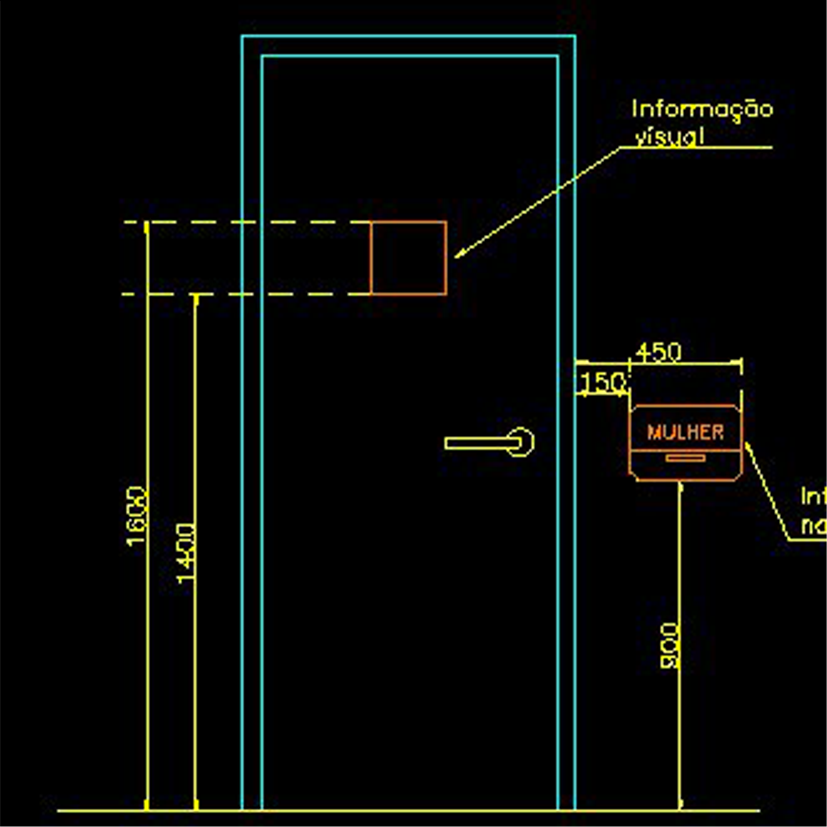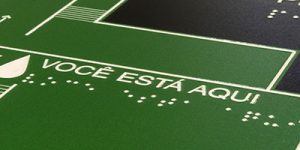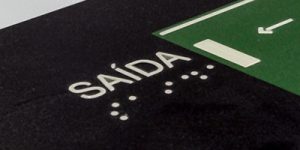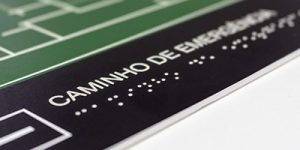Braille signage
We ensure inclusion, we guarantee guidance, we expand support technology.
We are proud to be pioneers in Portugal in the manufacture of Braille signage. From day one, we took on the social responsibility of promoting equality by designing more functional and adapted spaces. To this end, we created a development team exclusively for the creation of Braille signage systems.
Braille signage can be combined with photoluminescent signage to create integrated signs for everyone.
Identification and orientation signs

The purpose of orientation signs is to guide people through a space, helping them to understand the layout of the environment. It is essential to ensure that they can navigate easily and safely, especially in complex or unfamiliar places.
S3F Signs is firmly committed to quality and personalisation in the production of these signs. We adapt to the specific needs of each client and environment.

Tactile Plants

Tactile floor plans are three-dimensional representations of spaces, with different textures and relief elements. They serve to provide clarity in the layout of rooms, corridors, entrances and exits, allowing the structure of the space to be fully understood.
With our accessible and functional design, our floor plans are intuitive and easy to use, made of durable and suitable materials.

Tactile signalling
This type of signage uses tactile elements, such as relief and textures, to convey information effectively, allowing users to perceive and understand their surroundings through touch.
Doors should have visual information (room number or function). The tactile signage (in Braille or raised text) will be installed on the wall, on the side where the door handle is, at a height of between 0.90m and 1.10m, as shown in the figure.

ACAPO
Our team’s consultative partner is ACAPO (Associação de Cegos e Amblíopes de Portugal), to whom we submit all Braille signs and support equipment (podotactile floors) produced by our company for verification and subsequent approval.
Braille Systems
Pitons

This product consists of studs made from high-quality stainless steel or plastic.
The studs are applied to floors in order to create tactile surfaces for the orientation of blind or partially sighted people.
They are designed in one piece to guarantee stable, long-lasting performance. Their top is non-slip to offer greater resistance to slipping.
Product available in stainless steel with various finishes and in plastic in standard colours of yellow and red.
LOGES tactile language codes
Two second-level codes have been added to the two basic codes, the straight route and danger codes, which complete the information horizon for greater safety and safer guidance.
Information
The abolition of architectural barriers is now provided for in the legislation of all democratic countries. It is worth noting that the concept of architectural barriers also includes perceptual barriers, which prevent or hinder the autonomous mobility of blind people.
The full right of blind people to take advantage of these actions was recently reinforced by the UN Convention on the Rights of Persons with Disabilities, ratified by Italy with the law of 25 February 2009, as well as by 80 other countries around the world.
The CEN 12199 standard concerns the technical characteristics of materials and not tactile paths.
In addition, there is a European standard, CEN/TS 15209, which at the moment only provides for 2 codes, stop and go, and not the 4 second level standards, which are indispensable for building tactile routes that can be fully utilised by those who cannot see and which also exist in the Loges system.
Guidance and Safety Guideline
The LOGES TACTILE GUIDE SYSTEM was designed by a team of professionals with experience in mobility problems, both for the blind and people with low vision. It was studied and developed after verifying the problems detected in other tactile route profiles, taking into account the mobility used by blind people during their journeys, centred on the use of the tactile, plantar and kinaesthetic senses, as well as the use of the white cane.
The Loges
This system has a profile that fully respects the physiology of the step and is perfectly perceptible both indoors and outdoors. What’s more, it has been tested by associations of people with motor disabilities who claim that it doesn’t create any problems for them.
Allows the designer to create a rational and organised route, thanks to which blind people who are able to move around on their own can acquire complete autonomy during their journeys.
Includes all the tactile codes necessary and sufficient to provide blind people with the information they need to travel safely and in an orientated manner, while also enabling them to identify the position of topographical relief maps.
Is made up of modular elements that can be applied during the construction of pre-existing pavements or paving.
- Is the only tactile path that has been widespread in Italy since 1996, with tens of thousands of installations, and is also used in Greece, Portugal and France.
It is commercialised by S3F and made of rubber, which makes it fully perceptible to blind people, due to the different acoustic response of this material compared to the surrounding paving.
It is the only one that allows several metres of continuous track to be laid, without interruptions, leaks or unevenness, allowing the blind person to slide the tip of the cane in the grooves without any obstacle, for fluid and fast movement.
Is produced in 4 colours so that the designer can fit it into any environment in the best way (yellow, red, light grey, dark grey). The possibility of using several colours is essential above all to guarantee the luminance contrast needed to highlight the tactile signal in relation to its surroundings, as required by the law on the protection of people with low vision.
The sign can also be installed outdoors with special UV-resistant mixtures and its application must be completely flat.





